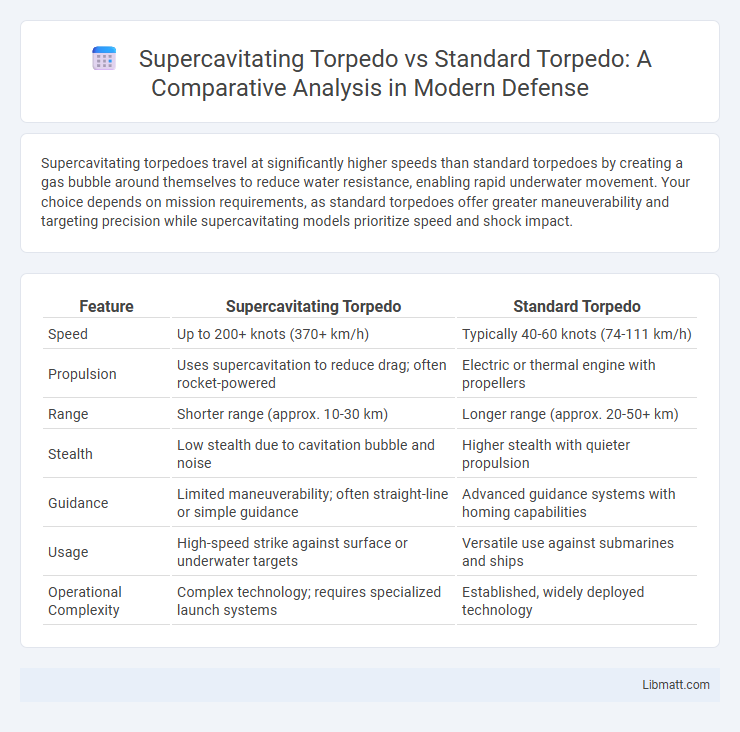Supercavitating torpedoes travel at significantly higher speeds than standard torpedoes by creating a gas bubble around themselves to reduce water resistance, enabling rapid underwater movement. Your choice depends on mission requirements, as standard torpedoes offer greater maneuverability and targeting precision while supercavitating models prioritize speed and shock impact.
Table of Comparison
| Feature | Supercavitating Torpedo | Standard Torpedo |
|---|---|---|
| Speed | Up to 200+ knots (370+ km/h) | Typically 40-60 knots (74-111 km/h) |
| Propulsion | Uses supercavitation to reduce drag; often rocket-powered | Electric or thermal engine with propellers |
| Range | Shorter range (approx. 10-30 km) | Longer range (approx. 20-50+ km) |
| Stealth | Low stealth due to cavitation bubble and noise | Higher stealth with quieter propulsion |
| Guidance | Limited maneuverability; often straight-line or simple guidance | Advanced guidance systems with homing capabilities |
| Usage | High-speed strike against surface or underwater targets | Versatile use against submarines and ships |
| Operational Complexity | Complex technology; requires specialized launch systems | Established, widely deployed technology |
Introduction to Torpedo Technology
Supercavitating torpedoes utilize a gas bubble to drastically reduce water resistance, allowing them to travel at speeds exceeding 200 knots, compared to standard torpedoes that typically reach 50-60 knots. This advanced technology transforms underwater propulsion by creating a vapor cavity around the torpedo, significantly improving speed and maneuverability in combat scenarios. Your understanding of these innovations highlights the cutting-edge developments shaping modern naval warfare.
What Is a Supercavitating Torpedo?
A supercavitating torpedo is a specialized underwater missile designed to travel at extremely high speeds by creating a gas bubble around itself, drastically reducing drag and allowing it to move faster than conventional torpedoes. Unlike standard torpedoes that rely on traditional propulsion and cause significant water resistance, supercavitating torpedoes use a cavitation bubble generated by gas or a specially designed nose to minimize contact with water. This technology enables supercavitating torpedoes to achieve velocities exceeding 200 knots, making them significantly faster and harder to counteract in naval warfare.
Standard Torpedoes: Overview and Operation
Standard torpedoes operate by propelling underwater using a conventional propulsion system, relying on propellers and control surfaces to navigate through water at speeds typically up to 50 knots. Unlike supercavitating torpedoes, standard torpedoes generate significant drag from water resistance, limiting their velocity and range. Your understanding of these differences highlights the trade-offs between traditional underwater stealth and speed in torpedo design.
Speed Comparison: Supercavitating vs Standard Torpedoes
Supercavitating torpedoes achieve speeds exceeding 200 knots by creating a vapor cavity around the hull, drastically reducing water resistance, compared to standard torpedoes that typically reach speeds of 50 to 70 knots. The supercavitation effect enables these torpedoes to travel three to four times faster, significantly reducing target engagement time. Standard torpedoes rely on conventional propulsion and hydrodynamic design, limiting their maximum speed due to friction and drag from water.
Propulsion Systems and Hydrodynamics
Supercavitating torpedoes utilize gas-filled cavities around the projectile, drastically reducing drag by enveloping the body in a vapor bubble, enabling speeds exceeding 200 knots, compared to standard torpedoes which rely on propellers and conventional hydrodynamic designs with speeds typically around 50 knots. The propulsion system in supercavitating torpedoes often involves rocket engines or high-thrust gas propulsion to maintain the cavity and high velocity, whereas standard torpedoes use electrical or thermal engines driving propellers optimized for underwater maneuvering and stability. Hydrodynamically, supercavitating torpedoes minimize fluid resistance through cavitation principles, while standard torpedoes focus on streamlined hull designs to optimize flow efficiency and control in turbulent underwater environments.
Guidance and Control Mechanisms
Supercavitating torpedoes utilize advanced guidance and control mechanisms that operate effectively at extremely high speeds underwater by stabilizing the cavitation bubble and using hydrodynamic forces for maneuvering, unlike standard torpedoes which rely on traditional fins and propellers for direction control. The precise control within the vapor cavity allows supercavitating torpedoes to maintain trajectory with minimal drag, achieving greater velocity and reduced detection risk. Your choice of torpedo technology impacts operational performance, especially in scenarios demanding rapid target engagement and evasion.
Operational Advantages of Supercavitating Torpedoes
Supercavitating torpedoes achieve significantly higher speeds than standard torpedoes by creating a gas bubble that reduces water drag, enabling rapid target engagement and minimizing interception risk. Their enhanced maneuverability and reduced acoustic signature improve stealth capabilities, allowing more effective strikes in hostile environments. You benefit from increased tactical flexibility, as supercavitating torpedoes shorten engagement times and expand operational reach in naval combat scenarios.
Limitations and Challenges of Supercavitation
Supercavitating torpedoes face significant limitations such as reduced maneuverability and stability compared to standard torpedoes, which restrict their operational flexibility in complex underwater environments. The generation and maintenance of a stable vapor cavity require precise speed and control, making them vulnerable to changes in water conditions and mechanical failures. Your strategic deployment must consider these challenges, as conventional torpedoes offer better guidance and adaptability despite slower speeds.
Tactical Applications and Military Impact
Supercavitating torpedoes achieve significantly higher speeds by enveloping themselves in a gas bubble, enabling rapid engagement of high-value or fast-moving targets compared to standard torpedoes which rely on conventional propulsion with slower speeds. This speed advantage allows your military forces to execute surprise attacks and intercept enemy vessels before they can deploy countermeasures, enhancing tactical flexibility in naval warfare. The introduction of supercavitating technology shifts the strategic balance by reducing reaction times and increasing the lethality of underwater weapons systems, compelling adversaries to develop new defensive strategies.
Future Developments in Torpedo Technology
Supercavitating torpedoes leverage gas bubbles to reduce drag, enabling speeds exceeding 200 knots, significantly faster than standard torpedoes which typically travel around 50 knots. Future developments aim to enhance guidance systems using AI and improve energy efficiency through advanced battery technologies, pushing operational range and precision. Integration of stealth features and autonomous target recognition promises to transform underwater combat dynamics by increasing survivability and effectiveness.
supercavitating torpedo vs standard torpedo Infographic

 libmatt.com
libmatt.com